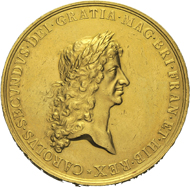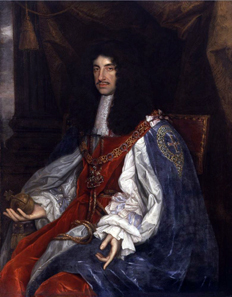… ‘and at my goldsmith’s I did observe the King’s new medal, where, in little, there is Mrs. Steward’s face as well done as ever I saw anything in my whole life, I think: and a pretty thing it is, that he should choose her face to represent Britannia by.’ – From the diary of Samuel Pepys, entry from February 25, 1667.
Early in the year 1667, the chief die cutter of the London Mint, John Roettiers, designed a medal for the English king. This medal shows the portrait of Charles II with long hair and laurel wreath on its obverse. The inscription translates: Charles II, King by grace of God of Great Britain, France and Ireland. On the reverse, Britannia proudly looks at the English fleet. The inscription reads: by favor of God. One of the rare specimens of this medal in gold will be auctioned off in the upcoming auction of Künker’s in Osnabrück, in the week from June 17 to 21, 2013, together with many more medals dealing with the subject ‘Pax in Nummis’.
Medal by J. Roettiers on the Treaty of Breda. From the upcoming Künker auction 232 (2013), 304.
This medal is a beautiful testimony to the major power policy of Charles II who planned to cut out the Netherlands from their role as leading trading nation. That had been the intent of Oliver Cromwell already, who had made a war against the Netherlands from 1652-1654. Apart from a highly lucrative treaty, England had gained 120 million pounds booty alone. That was a proud sum, considering the fact that all government expenses in 1652/3 amounted to 53 million pounds only. Now it was Charles II who was in need of money. The English navy commander summarized as follows: ‘Who really cares about this reason or any other? What we need is a further part of the trade the Dutchmen are having right now.’
Let us skip the order of the war’s events. England won. It had the better navy and the better strategy. Hadn’t it been for the great fire of 1666 that devastated London and supported a general war fatigue, who knows what huge demands Charles II would have raised! This way, however, he was forced to reduce his fleet. The big liners were decommissioned, and the war was being gone easy on. At the same time, he put out feelers to initiate negotiations with the Dutchmen.
Portrait of Charles II by John Michael Wright (1617-1694). Source: National Portrait Gallery / Wikipedia.
Such was the historical situation when Charles II issued our medal that summarized his claim to naval supremacy. It displays Britannia as ruler of the sea. She looks upon the huge English fleet, which, actually, wasn’t that awe-inspiring anymore at the time the medal was produced. Here, Britannia appears in a new guise. She becomes the embodiment of the English claim to power as which she will appear on the coins regularly until 1672.
Portrait of Frances Theresa Stuart, Duchess of Richmond and Lennox, c. 1662/1665 by Peter Lely (1618-1680). Source: Royal Collection, Hampton Court Palace / Wikipedia.
All the more interesting is a detail that Samuel Pepys reveals to us in his diary. Pepys held a high function in the naval office which is why he regularly paid the palace a visit. He personally knew Frances Stewart. She was the daughter of the old queen’s personal doctor and was a quite distant relative of Charles II. In addition, the young lady was beautiful – beautiful to such an extent that even the king fell in love with ‘La Belle Stuart’. Frances Stewart was to become famous for not agreeing to become the mistress of the royal gentleman. Perhaps it was part of the kingly compliments that Charles II himself decided for the facial features of gorgeous Frances Stewart to become the model of Britannia.
Anyhow, the king’s mistress, Lady Castlemain, who had born the ruler five children up to that time, feared for her influence. She went after the young lady and ‘caught’ her in the act with the Duke of Richmond. They had no other chance than to marry.
The king condoned Frances Stewart. And he is said to have granted her his affection even when her flawless complexion was utterly ruined by the smallpox.
Oh well, the Treaty of Breda that was concluded on July 13, 1667. It brought New York and New Jersey under English control and expelled the Dutchmen from North America for good.
The auction catalogues are online.
And the medal you will find here.
You can read an auction preview here.







